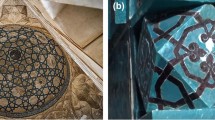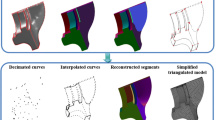Abstract
Motivated by the current requirements of digital 3D museums in the low bandwidth networks, we present a novel and efficient approximation algorithm based on axial symmetry of 3D pottery model. Available simplification algorithms suppress detailed features of the mesh without any change to the rest of 3D model. In this paper, we reduce data for mesh representation while preserving the geometric approximation as well as the model quality of the resulting mesh. First, the main symmetry axis of the pottery model is determined and then main body is detected by slicing parallel planes and separation criteria introduced in our proposed algorithm. Second, actual handles are detected based on sector slicing planes using a robust handle separation scheme. Third, every detected part, i.e. main body and handles, is approximated using a novel circle fitting method. Finally, generated vertices are remeshed and create approximated mesh. Experimental results are presented to illustrate superiority and affectivity of our method. Compared with available mesh simplification algorithms and using the same amount of data to represent the model, the proposed approach gives significant improvement in the accuracy of the approximated 3D potteries.

























Similar content being viewed by others
References
Abdi H, Williams LJ (2010) Principal component analysis. Wiley Interdisciplinary Reviews. Comput Stat. doi:10.1002/wics.101
Aspert N, Santa-Cruz D, Ebrahimi T (2002) MESH: measuring errors between surfaces using the Hausdorff distance. In: Proceedings International conference on Multimedia and Expo, 2002. ICME ‘02. Proceedings, Vol 1, pp 705–708
Bokeloh M, Wand M, Seidel H-P (2010) A connection between partial symmetry and inverse procedural modeling. ACM Trans Graph 29. doi10.1145/1778765.1778841
Botsch M, Kobbelt L, Pauly M, Alliez P, Levy B (2010) Polygon mesh processing. Peters A K, Massachusetts
Brodsky D, Watson B (2000) Model simplification through refinement. Proc Graph Interface 2000:221–228
Buades A, Coll B, Morel J-M (2008) Nonlocal image and movie denoising. Int J Comput Vis 76(2):123–139. doi:10.1007/s11263-007-0052-1
Castellóa P, Choverb M, Sbertc M, Feixasc M (2014) Reducing complexity in polygonal meshes with view-based saliency. Comput Aided Geom Des 31:279–293. doi:10.1016/j.cagd.2014.05.001
Chen X, Golovinskiy A, Funkhouser T (2009) A benchmark for 3D mesh segmentation. ACM Trans Graph (SIGGRAPH) 28(3) Art. 73. doi:10.1145/1531326.1531379
Choi KH, Kim HS, Lee KH (2010) An improved mesh simplification method using additional attributes with optimal positioning. Int J Adv Manuf Technol 50(1–4):235–252. doi:10.1007/s00170-009-2484-y
Cohen J, Varshney A, Manocha D, Turk G, Weber H, Agarwal P et al (1996) Simplification envelopes. In: proc. SIGGRAPH 96, pp 119–128
Duda RO, Hart PE (1972) Use of the Hough Transformation to detect lines and curves in pictures, communications of the Association of Computing. Machinery 15:11–15. doi:10.1145/361237.361242
Gal R, Sorkine O, Mitra NJ and Cohen-OR D (2009) iwires: an analyze-and-edit approach to shape manipulation. ACM Trans. on Graphics (Proc. SIGGRAPH) 28(3):1–10. doi: 10.1145/1531326.1531339
Gao S, Zhao W, Lin H, Yang F, Chen X (2010) Feature suppression based CAD mesh model simplification. Comput Aided Des 42:1178–1188. doi:10.1016/j.cad.2010.05.010
Garland M, Heckbert PS (1997) Surface simplification using quadric error metrics. Comput Graph 31:209–216. doi:10.1145/258734.258849
Gotsman C, Gumhold S, Kobbelt L (2002) Simplification and compression of 3D meshes. Tutorials on multiresolution in geometric modelling. Mathematics and visualization, pp 319–361
Guéziec A (1999) Locally toleranced surface simplification. IEEE Trans Vis Comput Graph 5(2):168–189. doi:10.1109/2945.773810
Heckbert PS, Garland M (1997) Survey of polygonal surface simplification algorithms. SIGGRAPH 97 courses notes
Hoppe H (1996) Progressive meshes. In: Proceedings of the 23rd Annual Conference on Computer Graphics and Interactive Techniques (ACM SIGGRAPH), New Orleans, Louisiana, United States, 4–9 August, pp 99–108
Hoppe H, DeRose T, Duchamp T, McDonald J, Stuetzle W (1993) Mesh optimization. In: proc. SIGGRAPH 93, pp 19–26
Ioannoua D, Hudab W, Laine AF (1999) Circle recognition through a 2D hough transform and radius histogramming. Image Vis Comput 17:15–26. doi:10.1016/S0262-8856(98)00090-0
Koutsoudis A, Pavlidis G, Arnaoutoglou F, Tsiafakis D, Chamzas1 C (2008) A 3D pottery database for benchmarking content based retrieval mechanisms. In: Pratikakis I, Theoharis T (ed) Eurographics Workshop on 3D Object Retrieval
Luebke D, Erikson C (1997) View-dependent simplification of arbitrary polygonal environments. In: proc. SIGGRAPH 97, pp 199–208
Morigi S, Rucci M (2013) Multilevel mesh simplification. Vis Comput 30(5):479–492. doi:10.1007/s00371-013-0873-6
Pavlidis G, Tsirliganis N, Tsiafakis D, Arnaoutoglou F, Chamzas C, Tsioukas V, Mpakourou E, Mexia A (2006) 3D digitization of monuments: the case of Mani. In: Proceedings of the third International Conference on Museology, June ‘06
Payne A, Cole K, Mainfort R, Goodmaster C, Simon K, Smallwood S, Limp F (2009) The Hampson virtual museum, Center for Advanced Spatial Technologies, Fayetteville, Arkansas, http://hamsponmuseum.cast.uark.edu. Accessed 14 Jun 2009
Ronfard R, Rossignac JR (1996) Full-range approximation of triangulated polyhedra. In: Proceedings Eurographics 15(3):67–76. doi: 10.1111/1467-8659.1530067
Rossignac J, Borrel P (1993) Multi-resolution 3D approximations for rendering complex scenes. In: Falcidieno B, Kunii T (eds) Modeling in computer graphics: methods and applications. Springer-Verlag, Berlin, pp 455–465
Schroeder WJ, Zarge JA, Lorensen WE (1992) Decimation of triangle meshes. In: Proceedings of the 19th Annual Conference on Computer Graphics and Interactive Techniques (ACM SIGGRAPH), Chicago, Illinois, United States, 27–31 July, pp 65–70
Shaffer E, Garland M (2001) Efficient adaptive simplification of massive meshes. In: IEEE visualization 01, pp 127–34
Shamir A (2008) A survey on mesh segmentation techniques. Comput Graphics Forum 27:1539–1556. doi:10.1111/j.1467-8659.2007.01103.x
Shi B-Q, Liang J, Liu Q (2011) Adaptive simplification of point cloud using k-means clustering. Comput Aided Des 43:910–922. doi:10.1016/j.cad.2011.04.001
Shiaw HY, Jacob RJK, Crane GR (2004) The 3D vase museum: a new approach to context in a digital library. In: Proceedings of the ACM/IEEE Conference on Digital Libraries, USA, June 7–11, pp 125–134
Shu Z-Y, Wang G-Z, Dong C-S (2009) Adaptive triangular mesh coarsening with centroidal Voronoi tessellations. J Zhejiang Univ Sci A 10(4):535–545. doi:10.1631/jzus.A0820229
Soucy M, Laurendeau D (1996) Multiresolution surface modeling based on hierarchical triangulation. Comput Vis Image Underst 63(1):1–14. doi:10.1006/cviu.1996.0002
Thomas DM, Yalavarthy PK, Karkala D, Natarajan V (2012) Mesh simplification based on edge collapsing could improve computational efficiency in near infrared optical tomographic imaging. Sel Top Quantum Electron 18(4):1493–1501. doi:10.1109/JSTQE.2012.2187276
Tsirliganis N, Pavlidis G, Koutsoudis A, Papadopoulou D, Tsompanopoulos A, Stavroglou K, Politou E, Chamzas C (2002) New ways in digitization and visualization of cultural objects. In: Proc. IEEE DSP 2002, vol. 1, pp 475–478
Turk G (1992) Re-tiling polygonal surfaces. In: SIGGRAPH 92, pp 55–64
Turk G (2001) Texture synthesis on surfaces. In: SIGGRAPH 01, pp 327–354
Valette S, Chassery JM, Prost R (2008) Generic remeshing of 3D triangular meshes with metric-dependent discrete voronoi diagrams. IEEE Trans Vis Comput Graph 14(2):369–381. doi:10.1109/TVCG.2007.70430
Witkin A, Heckbert P (1994) Using particles to sample and control implicit surfaces. In: SIGGRAPH 94, pp 269–277
Zheng Q, Sharf A, Wan G, Li Y, Mitra NJ, Cohen-OR D, Chen B (2010) Non-local scan consolidation for 3d urban scenes. ACM Trans Graph 29(4). doi:10.1145/1778765.1778831
Author information
Authors and Affiliations
Corresponding author
Rights and permissions
About this article
Cite this article
Mansouri, S., Ebrahimnezhad, H. Efficient axial symmetry aware mesh approximation with application to 3D pottery models. Multimed Tools Appl 75, 8347–8379 (2016). https://doi.org/10.1007/s11042-015-2753-8
Received:
Revised:
Accepted:
Published:
Issue Date:
DOI: https://doi.org/10.1007/s11042-015-2753-8




